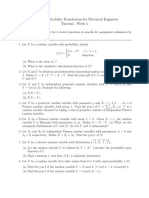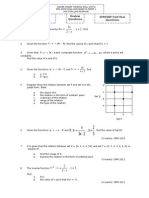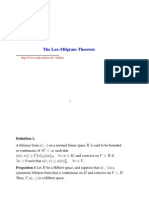Probability Assignment 3
Uploaded by
achutunisrProbability Assignment 3
Uploaded by
achutunisrAssignment 3
(MA6.102) Probability and Random Processes, Monsoon 2024
Release date: 7 September 2024, Due date: 14 September 2024
I NSTRUCTIONS
• Discussions with other students are not discouraged. However, all write-ups must be done individually
with your own solutions.
• Any plagiarism when caught will be heavily penalised.
• Be clear and precise in your writing.
• Coding portion can be done in Python/Matlab. There will be a moss check, code copying will result
in a straight 0.
• Submit a zipped folder (rollnumber.zip) containing your handwritten solutions (PDF), code and PDF
of plots.
Problem 1. Let X1 , X2 , . . . , Xn be independent random variables and let X = X1 + X2 + · · · + Xn .
Suppose that each Xi is a Bernoulli random variable with parameter pi , and that p1 , p2 , . . . , pn are chosen
so that the mean of X is a given µ > 0. Show that the variance of X is maximized if the pi values are
chosen to be all equal to nµ .
Problem 2. Prove the following.
If X is a positive integer valued random variable satisfying
P (X > m + n|X > m) = P (X > n)
for any two positive integers m and n, then X is a geometric random variable.
Problem 3. (a) Give examples of two discrete random variables that are uncorrelated but not independent.
(b) Give examples of two discrete random variables where uncorrelatedness guarantees independence.
Problem 4. For any two random variables X and Y , Cauchy-Schwarz inequality states that
p
|E[XY ]| ≤ E[X 2 ]E[Y 2 ]
with equality if and only if X = αY , for some constant α ∈ R. Prove this, and use it to show that
|ρ(X, Y )| ≤ 1, where ρ(X, Y ) is the correlation coefficient of X and Y given by
E[XY ] − E[X]E[Y ]
ρ(X, Y ) = p .
var(X)var(Y )
[Hint: Observe that E[(X − αY )2 ] ≥ 0, for all α ∈ R]
Problem 5. Let ϕ(Y ) = E[X|Y ]. For any function g : R → R, show that
E[ϕ(Y )g(Y )] = E[Xg(Y )].
Argue that the law of iterated expectations, ie., E [E [X|Y ]] = E[X], is a special case of this.
Problem 6. (a) For any discrete random variable X and any event A such that P (A) > 0, show that
E[1A X]
E[X|A] = ,
P (A)
where 1A is the indicator random variable of event A.
(b) X denotes the sum of outcomes obtained by rolling a die twice and Ai is the event that the first
die shows i, for i ∈ [1 : 6]. Compute E[X|Ai ], for i ∈ [1 : 6].
Problem 7. You toss a fair coin 100 times. After each toss, either there have been more heads, more
tails, or the same number of heads and tails. Let X be the number of times in the 100 tosses that there
were more heads than tails. Estimate the PMF of X via simulation and plot it. Show that the most likely
number of times you have more heads than tails when a coin is tossed 100 times is zero.
Now, once you have shown that the most likely number of times you have more heads than tails when
a coin is tossed 100 times is zero, suppose you toss a coin 100 times.
(a) Let Y be the number of times in the 100 tosses that you have exactly the same number of heads
as tails. Estimate the expected value of Y .
(b) Let Z be the number of tosses for which you have more heads than tails. Estimate the expected
value of Z.
You might also like
- Probabilistic Methods in Combinatorics - Prob-CombNo ratings yetProbabilistic Methods in Combinatorics - Prob-Comb7 pages
- E2 202 (Aug-Dec 2015) : Homework Assignment 4No ratings yetE2 202 (Aug-Dec 2015) : Homework Assignment 41 page
- 1 + X E (X Is Is Integrable, But Not Square Is Not Integrable, The Variance IsNo ratings yet1 + X E (X Is Is Integrable, But Not Square Is Not Integrable, The Variance Is18 pages
- 2019 Randomized Algorithm Design Assignment 1No ratings yet2019 Randomized Algorithm Design Assignment 12 pages
- Random Variables: - Definition of Random VariableNo ratings yetRandom Variables: - Definition of Random Variable29 pages
- Probability Theory and Stochastic Processes: Unit-2No ratings yetProbability Theory and Stochastic Processes: Unit-231 pages
- Probabilistic Method: Aditya Ghosh 26 February, 2021No ratings yetProbabilistic Method: Aditya Ghosh 26 February, 202115 pages
- EC404 - Monsoon 2016 Archana Aggarwal Introduction To Statistics and Econometrics 307, SSS-II Problem Set 1No ratings yetEC404 - Monsoon 2016 Archana Aggarwal Introduction To Statistics and Econometrics 307, SSS-II Problem Set 14 pages
- Properties of Expectation Expectation of A Sum: - PropositionNo ratings yetProperties of Expectation Expectation of A Sum: - Proposition16 pages
- Information and Communication Assignment 1No ratings yetInformation and Communication Assignment 13 pages
- HOTS Drill 1 Exercise Paper 1 Functions 2015100% (1)HOTS Drill 1 Exercise Paper 1 Functions 201513 pages
- 231MAB202T-I RA-II Semester - With Corrected Blooms TaxanomyNo ratings yet231MAB202T-I RA-II Semester - With Corrected Blooms Taxanomy3 pages
- Linear Transformation:: T (u +u) =T (u) +T (u) for all u ,u U T (αu) =αT (u) for all u U and all α FNo ratings yetLinear Transformation:: T (u +u) =T (u) +T (u) for all u ,u U T (αu) =αT (u) for all u U and all α F6 pages
- Revaluation Results of I B Tech II Sem Regular & Supply Exams, JulyNo ratings yetRevaluation Results of I B Tech II Sem Regular & Supply Exams, July26 pages
- Lax Milgram Theorem - Universität BaselNo ratings yetLax Milgram Theorem - Universität Basel23 pages
- Comparative Analysis of Six Methods For Solving Volterra Integral Equations of The Second KindNo ratings yetComparative Analysis of Six Methods For Solving Volterra Integral Equations of The Second Kind42 pages
- Complex Numbers - Typical Exam QuestionsNo ratings yetComplex Numbers - Typical Exam Questions2 pages
- MAT-142 - PPT - Function-Monsoon 2021 - StudentNo ratings yetMAT-142 - PPT - Function-Monsoon 2021 - Student38 pages
- TB Homework 65bb5b412a3cf4.65bb5b43d6d373.99991714No ratings yetTB Homework 65bb5b412a3cf4.65bb5b43d6d373.999917147 pages
- A.N. Kolmogorov, S.V. Fomin-Elements of The Theory of Functions and Functional Analysis, Volume 1, Metric and Normed Spaces-GRAYLOCK PRESS (1963) PDF67% (3)A.N. Kolmogorov, S.V. Fomin-Elements of The Theory of Functions and Functional Analysis, Volume 1, Metric and Normed Spaces-GRAYLOCK PRESS (1963) PDF141 pages
- (L1) - (JEE 2.0) - Differential Equation - 4th DecNo ratings yet(L1) - (JEE 2.0) - Differential Equation - 4th Dec49 pages





























































































